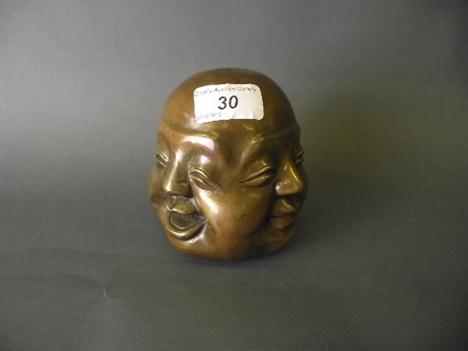We found 389642 price guide item(s) matching your search
There are 389642 lots that match your search criteria. Subscribe now to get instant access to the full price guide service.
Click here to subscribe- List
- Grid
-
389642 item(s)/page
A good Chinese bronze incense burner, probably 18th century. Crisply cast with animal mask handles and a central band of mythical beasts including dragons and winged horses, the rim and foot with stylized scroll work, the base with a four character mark Yu Tang Shi Sou (Jade Hall Stone Old Man), the body with a warm brown patina, 28.5cm. This rare mark including the characters for Shi Sou is more commonly found on figures.
A Chinese gilt bronze seated figure of Avalokiteshvara, 17th century. Wearing a diadem and elaborate necklace over long flowing robes, raised on rockwork and with an animal at her feet, 13.5cm. Provenance: by repute, from the collection of the late M.S.D. Westropp, Keeper of Antiquities at The National Museum of Ireland and then by descent.
A good Chinese gilt bronze figure of Vairocana Buddha, c.16th century. Seated in dhyanasana mudra, wearing a seven pointed crown and jewelled robe, seated on a crisply cast double lotus throne, cast with a two character mark inside the base, xiang zheng, attribute missing from his outstretched hand, 21.5cm.
An Extremely Rare Chinese Imperial Gilded Spinach-Green Jade Buddhist Lion Dog. Qing dynasty, Qianlong period 1736-95, 20cm. Boldly carved from a massive spinach-green boulder, crouching with his head turned to the left and baring his teeth to reveal a slightly upturned tongue. The face with large eyes above a ruyi-shaped nose, tilts upwards; the angular chin is fringed with a short curling beard. His floppy scroll-like ears fall either side of the head and are divided by four rows of a tightly scrolling mane. The form of his body is accentuated by the pronounced, well-defined spine from which his flame-like coat falls. The mane, hair and scrolling tail are all finely incised and heightened in gold. The underside reveals four crisp claws beneath each paw. Provenance: The Bruce Collection, the 3rd Baron Alington of Crichel (1896-1940), the Hon. Mrs Mary Anna Marten OBE (1929-2010), Crichel House, Dorset.Exhibited: The International Exhibition of Chinese Art, The Royal Academy of Arts, London, 1935/6, catalogue no.2821. Illustrated: S C Nott, Chinese Jade Throughout the Ages, Pl.LXIII. Catalogue note: The lion was first introduced into China from India, following the arrival of Buddhism, and is not represented in jade carvings earlier than the Han Dynasty. The lion is the king of beasts and is associated with high rank and military power. Most Buddhist temples in China have two lion dogs, carved in stone or cast in bronze or iron as guardian figures at the entrances. These figures are either depicted with both front legs on the ground, or with one foot raised on a ball and puppy; whereas with most jade examples, the lion is crouching, cf. J C S Lin, The Immortal Stone, Chinese jades from the Neolithic period to the twentieth century, p.52. Chinese lions resemble Pekingese dogs, and are known as ‘Lion Dogs’, and are often portrayed with brocade balls. According to tradition, Buddha was born ten times as a lion, six as an elephant and once as a hare.
A pair of Japanese bronze vases, Meiji 1868-1912. Intricately decorated in relief and onlaid in silver, gold and shakudo, one with four figures beside a waterfall and with a plaque inscribed with two lines of calligraphy, the other with a mother and two children in a mountainous landscape, with four flying cranes, 18cm. (2)
A fine and rare pair of Chinese champleve and gilt bronze boxes and covers, each with a four character Qianlong mark in black within a blue enamel square and of the period 1736-95. Heavily cast with square bodies and indented corners, delicately enamelled in blue, turquoise, pink, white, green and brick red with a complex geometric lotus scroll, the tops with a black line border, all on a rich gold ground, the interiors gilt, 7.5cm. (4) Provenance: formerly a private English collection, Ripon, Yorkshire, purchased at Tennants Auctioneers, 2002. Cf. Sotheby’s London, 13th November 2002, lot 22 for a similar single box and cover, but with the Qianlong mark within a red border.
-
389642 item(s)/page

























































